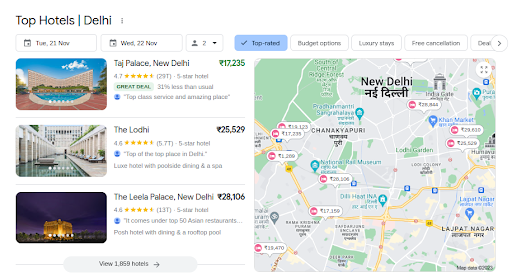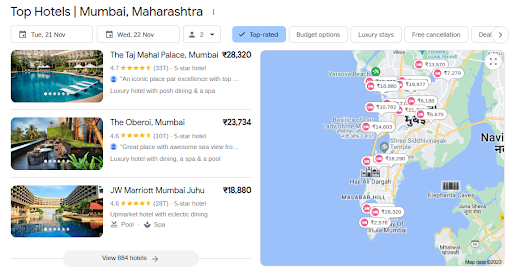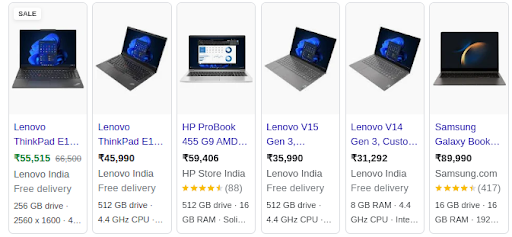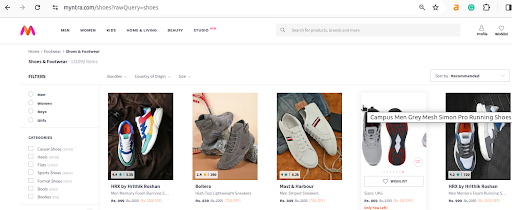What is Programmatic SEO: Definition, Pros and Cons, and How To Do It
November 27, 2023
Rudra Kumar
What has been updated from the old blog post:
- A practical definition of programmatic SEO updated.
- Advantages and disadvantages of programmatic SEO explained.
- Also added three pillars of programmatic SEO.
- Explained 8 steps + examples for creating programmatic SEO pages that can help interlinked content.
Summary: An extensive guide and tutorial on Programmatic SEO, spanning various aspects from definition and examples to its three pillars, pros and cons. Follow the detailed step-by-step guide to create programmatic SEO pages.
Ever wondered how e-commerce platforms effortlessly display related searches even when you haven’t entered specific keywords?
The secret lies in their aggressive use of Programmatic SEO.
This guide dives into what Programmatic SEO is, its advantages and disadvantages, and practical tips for making it work for your business. Understanding this approach will help you improve your website’s visibility and overall success online.
Let’s explore the basics of Programmatic SEO together!
Programmatic SEO: The Definition
In the context of search engine optimization (SEO), programmatic SEO, also known as pSEO, has emerged as a powerful technique for enhancing website visibility and attracting organic traffic.
Additional Read: What is SEO
This approach involves creating a large number of landing pages, each targeting a specific low-competition keyword. These pages are generated using automated tools and share a common template, ensuring consistency and efficiency.
Goibibo, a leading travel company, is a prime example of how programmatic SEO can be effectively utilized. When you search for “top hotels in Delhi,” you’re likely to encounter a Goibibo landing page among the top results. This is because they have leveraged programmatic SEO to create a vast network of landing pages, each tailored to a specific location and keyword combination.

For instance, the landing page for “top hotels in Delhi” differs from the one for “top hotels in Mumbai” in terms of the location and content, while maintaining the same overall layout and design. This allows Goibibo to effectively target and capture a wide range of travel-related search queries without manually creating each page from scratch.

Advantages of Programmatic SEO
Programmatic SEO offers several advantages, including:
- Scalability: The ability to generate a large number of landing pages quickly and efficiently.
- Targeting: The precision to target specific keywords and search queries.
- Efficiency: Automation streamlines the process, saving time and resources.
- Adaptability: The ability to adapt to changing search engine algorithms and user behavior.
Disadvantages of Programmatic SEO
While programmatic SEO offers significant benefits, it’s essential to consider potential drawbacks:
- Overreliance on Algorithms: Algorithms may lead to over-optimization or a lack of personalization.
- Potential Errors: Algorithms may introduce inaccuracies or technical issues.
- Continuous Adaptation: Algorithm changes require ongoing adjustments.
A balanced approach that combines automated strategies with human expertise is crucial to optimize websites for search engines while maintaining a positive user experience. Programmatic SEO will undoubtedly play an increasingly important role in shaping the success of businesses online as the digital landscape continues to evolve.
Three Pillars of Programmatic SEO
Imagine you have a virtual storefront and want to attract more customers. Programmatic SEO is like having a team of salespeople who can create custom storefronts for each product you sell.
1. The first pillar of programmatic SEO is to focus on keywords that are easy to rank for. Think of these as the keywords that people use when they are just starting to research a product or service. For example, if you sell shoes, you might target keywords like “best running shoes” or “comfortable shoes for work.”
2. The second pillar of programmatic SEO is to make sure your landing pages are aligned with the search intent of the keywords you are targeting. If someone is searching for “best running shoes,” they are probably looking for information about different brands and models. Your landing page should provide this information, as well as a clear call to action, such as “Shop now.”
3. The third pillar of programmatic SEO is to provide a great user experience. This means making sure your pages load quickly, are easy to navigate, and provide valuable content. You should also avoid using AI-generated content that is low quality or thin.
8 Easy Steps to Create Programmatic SEO Pages
Step 1: Keyword Research and Content Planning
The foundation of programmatic SEO lies in identifying relevant keywords that align with your target audience’s search intent. This involves understanding the specific terms and phrases users employ when seeking information or products related to your industry or niche.
To effectively conduct keyword research, consider utilizing keyword research tools that provide insights into search volume, competition levels, and related keywords. Additionally, analyze your competitors’ websites and content to uncover keywords they are effectively targeting.
Additional Read: Comparing Moz Pro, SEMrush, and Ahrefs
Another technique to find good keywords is to identify modifiers and related terms. For instance, instead of using the broad term “laptop,” opt for a more specific phrase like “best lightweight laptops for students.”
Incorporating related terms can broaden your content’s reach and attract a wider audience. For example, along with targeting “best lightweight laptops for students,” also consider incorporating related keywords like “student laptop deals,” “back-to-school essentials,” and “college tech recommendations.”

By strategically employing modifiers and related terms, you can enhance the relevance of your content and draw more visitors to your website.
Step 2: Design Your Page Template
Before diving into content creation, it is crucial to establish a clear and consistent template for your programmatic SEO pages. This template will serve as the blueprint for all the pages you generate, ensuring uniformity and a positive user experience across the board.
Start by outlining the essential elements of your page, such as the header, body content, sidebar, and footer. Define the layout and structure of each element, ensuring it aligns with your overall website design and branding guidelines.
 Source: Myntra
Source: Myntra
Consider incorporating user experience (UX) best practices into your page template. Ensure the layout is easy to navigate, the text is readable, and the overall design is visually appealing. Prioritize mobile responsiveness, as a significant portion of searches occur on mobile devices.
Step 3: Identify and Collect Your Data
The unique and valuable data you gather will serve as the backbone of your programmatic SEO pages. This data should be relevant to the keywords you have identified and provide a compelling reason for users to visit your pages.
The specific data you collect will vary depending on your industry or niche. For instance, an e-commerce website might collect product descriptions, pricing information, and customer reviews. A travel website could gather destination information, hotel listings, and travel tips.

Explore various methods for data collection, such as scraping websites, conducting surveys, or utilizing existing data sources. Ensure the data is accurate, up-to-date, and relevant to your target audience.
Step 4: Build the Database with Content and Labels
Once you have collected the necessary data, organize it into a structured database. Airtable is a user-friendly tool that can effectively handle large amounts of data and categorize it into fields tailored to your specific needs.
Create fields for each piece of content you intend to display on your programmatic SEO pages. Additionally, include fields for metadata, such as page titles, URLs, and descriptions.
Populate the database with the collected data, ensuring accuracy and completeness. Utilize Airtable’s filtering and sorting capabilities to easily manage and analyze your data.
Step 5: Optimize your page titles and meta descriptions
Your page titles and meta descriptions are two of the most important factors that search engines consider when ranking your pages. They are also the first things that people will see when your pages appear in search results, so they need to be informative and enticing.
Here are some tips for optimizing your page titles and meta descriptions:
- Include your target keywords in your page titles and meta descriptions, but don’t overdo it. Your titles and descriptions should still be natural and easy to read.
- Your page titles should be no more than 60 characters long, and your meta descriptions should be no more than 160 characters long.
- Your titles and descriptions should accurately reflect the content of your page. They should also be interesting and attention-grabbing.
- Your meta descriptions should include a call to action, such as “Click here to learn more” or “Shop now.”
Additional Read: On Page SEO
Step 6: Implement schema markup
Schema markup is a type of structured data that helps search engines understand the content of your pages. It is a way of telling search engines what your pages are about so that they can display them in more relevant search results.
 Source: Google’s Markup Testing tool
Source: Google’s Markup Testing tool
Here are some of the benefits of implementing schema markup:
- Improved search rankings: Schema markup can help your pages rank higher in search results.
- Increased click-through rate (CTR): Schema markup can make your pages more attractive to searchers, which can lead to an increased CTR.
- Richer snippets: Schema markup can enable rich snippets to appear in search results, which can provide more information about your pages to searchers.
To implement schema markup, you can use a variety of tools and resources, such as the
Google Structured Data Markup Helper and the Technical SEO schema generator tool.
Step 7: Use internal linking
Internal linking is the practice of linking to other pages on your website. This helps search engines understand the structure of your website and can improve your search rankings.
- The anchor text of your internal links should be relevant to the page you are linking to.
- Don’t use the same anchor text for all of your internal links. Use a variety of anchor text to keep your links natural and avoid keyword stuffing.
- Only link to pages that are relevant and high-quality. Avoid linking to pages that are thin or low-quality.
Additional Read: Internal Links Vs. External Links
Step 8: Monitor and analyze your results
It is important to monitor and analyze the results of your programmatic SEO efforts to see what is working and what is not. You can use a variety of analytics tools to track the performance of your pages, such as Google Analytics and Search Console.
A few things to keep in mind while monitoring and analyzing your results;
- Organic traffic: How much organic traffic are your programmatic SEO pages generating?
- Click-through rate (CTR): What is the CTR of your programmatic SEO pages and are they really compelling?
- Ranking: How are your programmatic SEO pages ranking in search results?
By monitoring and analyzing your results, you can identify which pages are performing well and which pages need to be improved. You can then make adjustments to your programmatic SEO strategy to improve the performance of your pages.
Importance of Programmatic SEO in 2024
Programmatic SEO is a powerful way to boost a website’s visibility and get more visitors. It uses automation to target specific audiences and helps make a site more popular on search engines. It’s great for growing a business online, but it’s important to remember it has its challenges, like relying too much on automated systems.
To make Programmatic SEO work well, it takes planning and continuous improvements. If you need help with this tricky but effective strategy, consider talking to the experts at Techmagnate. They know how to make your SEO work its best.
Ready to shine online? Reach out to Techmagnate and unlock the full potential of Programmatic SEO!